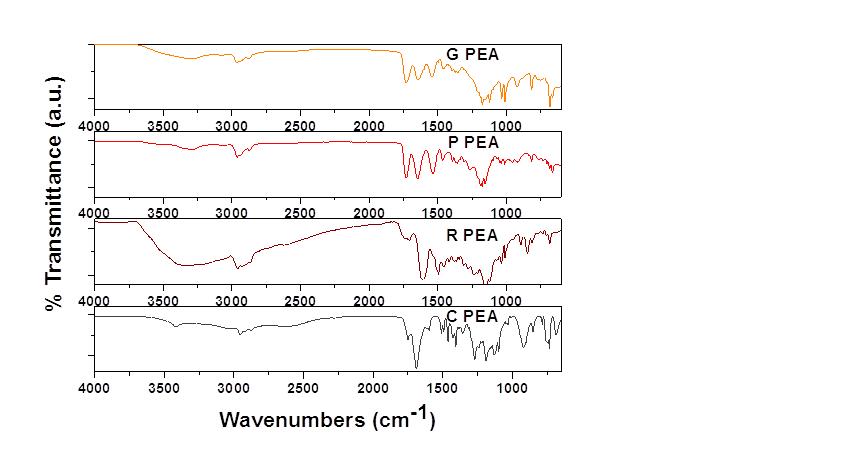Introduction: Biodegradable polymers have wide range of applications in the field of drug delivery and tissue engineering. Poly (ester amides) (PEAs) are an emerging class of biodegradable polymers which offer a good combination of optimal mechanical strength of poly amides and tuneable degradation kinetics of poly esters. PEAs prepared using amino acids can be degraded by enzymes and facilitate cell-material interactions. The goal of this work was to develop novel PEAs based on L-valine using diols with varying chain lengths such as ethylene glycol, 1,5 pentane diol, resorcinol and catechol and adipoyl chloride.
Materials and methods: The synthesis of PEAs was performed in two steps. The first step included the synthesis of diester p toluene sulphonates (PTSA) in the presence of toluene at 140°C for 48h by reacting 1 equivalent of L-valine and 2 equivalent of diols with 1.1 equivalent of PTSA. Subsequently, PEAs were synthesized by interfacial polymerization where 5 mmoL of diester p- toluene sulphonate with 10 mmoL of sodium carbonate solution was reacted with 15 mmoL of adipoyl chloride in dichloromethane. The molar ratio of L-valine : catechol was varied to study the effect of stoichiometry in the properties of the polymers.
The PEAs derived from ethylene glycol was named as G PEA, pentane diol as P PEA, resorcinol as R PEA and catechol as C PEA. In the case of different molar ratios, 1:0.25 as 0.25 C PEA, 1:0.5 as 0.5 C PEA, 1:1 as 1 C PEA, 1:4 as 4 C PEA and 1:8 as 8 C PEA.
Results and discussion: FTIR confirmed the chemical structure of the polymers. The in vitro hydrolytic degradation studies showed that the degradation slowed down with increasing chain lengths. G PEA showed the fastest degradation followed by P PEA. C PEA being aromatic showed slower degradation compared to P PEA and G PEA. R PEA showed the slowest degradation at the pH of 12 followed by pH of 10 but showed no degradation at pH of 7. Among the varying molar ratios, 0.25 C PEA showed the fastest degradation and 8 C PEA showed the slowest degradation. The degradation followed second order kinetics. The trend of dye release was similar to that of the degradation. MTT assay showed that all polymers were non cytotoxic except C PEA.

Conclusion: A library of L-valine based biodegradable PEAs was developed by interfacial polymerization. The properties of all PEAs varied considerably based on the diols. The rates of degradation and release of various PEAs were widely different. All polymers except C PEA were found to be cytocompatible. This study shows that a spectrum of polymers can be synthesized possessing different properties by altering the monomers and their ratios.
The authors would like to thank Department of Biotechnology (DBT), India for financial support.